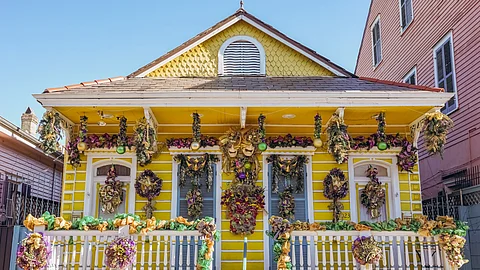
- Destinations
- Experiences
- Stay
- What's new
- Editor’s Picks
- Responsible Tourism
- CampaignsCampaigns
- Subscribe

It's celebration time in the US city of New Orleans, filled with exciting activities like cake eating, bead tossing, and parades to mark Mardi Gras Day. Fat Tuesday, or Mardi Gras, signifies the onset of the carnival season, characterised by processions, lively music, and cherished customs that enthral residents and tourists. Annually, the Mardi Gras season kicks off on Twelfth Night, observed on January 6, aligning with the Christian epiphany. This period of festivity, preceding Christian Lent, persists until Fat Tuesday—a tradition rooted in utilising all household fats before Lent in anticipation of fasting and abstinence. This year, February 13 marks the end of the carnival season.
Mardi Gras originated in 1699 in New Orleans, primarily marked by balls representing members of society. The Twelfth Night ball featured a king cake, with the finder of the bean becoming the subsequent host—a tradition continuing until Mardi Gras. In the contemporary context, balls are associated with parades, organisations, or krewes. The Mistick Krewe of Comus, a carnival crew, hosted the inaugural ball in 1857, while Rex's 1872 parade introduced the Mardi Gras king and the official colours: purple representing justice, green symbolising faith, and gold denoting power, all symbolic of the "king."
Lundi Gras, translating to Fat Monday in French, precedes Mardi Gras Day. Some parades take place that night, such as Proteus and Orpheus, while the day is commonly filled with lively lunches and festivities, including the creatively themed Red Beans Parade.
Mardi Gras Krewes
Krewes, representing diverse organisations, observe Mardi Gras through parades and balls, each possessing unique histories and traditions, typically led by an esteemed captain. These krewes frequently incorporate courts with annually changing royalty. Parade themes exhibit variability, drawing inspiration from historical events, legends, current affairs, and entertainment, often featuring satire and political humour in well-attended parades. Throws, dispensed by float riders, encompass items like beads, toys, cups, and distinctive objects such as the Muses shoe or Zulu coconut, aligning with the theme or krewe symbols.
Rex
Established in 1872, the Rex Organisation, responsible for the second official Mardi Gras parade, is the longest-running. The organisation is recognised for originating Mardi Gras royalty: Rex and his queen. Since "Rex" translates to the king, he is honoured as the King of Carnival. The organisation designated Mardi Gras' official colours and the royal anthem, "If I Ever Cease to Love," played at the exclusive, invitation-only Rex ball, concluding Mardi Gras each year.
Zulu
Zulu, established in the early 1900s as a Social Aid and Pleasure Club, initially provided financial assistance to the African American community. Their Mardi Gras Day parade debuted in 1915, eventually securing the St. Charles Avenue and Canal Street route in 1968. The distinct Zulu costume uses black face paint, wigs, and grass skirts. Traditionally, members threw coconuts, which are now distributed by hand to prevent injuries, originally symbolising gold, silver, and coal.
Mardi Gras involves masking traditions, dating back to escaping societal constraints. Float-riders, by law, wear masks for anonymity, along with themed costumes. Parade-goers also contribute to the festive atmosphere with colourful costumes on Fat Tuesday.
Flambeaux, introduced in 1857, illuminates parades carried by pedestrians who receive change in gratitude.
Mardi Gras Indians, tracing back to the 1800s, embody a unique subculture influenced by enslaved Africans and Native American connections.
King Cake, the official Mardi Gras food, is a festive dessert with icing in purple, green, and gold and contains a hidden baby, signifying a tradition where the finder purchases the next cake.
Best Time To Go
New Orleans gears up for Mardi Gras with major parades starting a week before Mardi Gras Day. Nightly processions by super-krewes and historic parades like Proteus, Rex, and Zulu mark the final week. Weekend parades, beginning on the Twelfth Night, lead to grand celebrations featuring favourites such as Endymion, Bacchus, Muses, and Tucks.
Where To Stay
Selecting accommodation for Mardi Gras depends on personal preferences. Parades occur in different neighbourhoods, with a popular route from Napoleon Avenue through Uptown to Canal Street near the French Quarter. Walking or biking is recommended due to transportation challenges. Hotels along St. Charles Avenue or Canal Street are well-received. Uptown is family-friendly, and some downtown hotels offer balcony views or stands.
